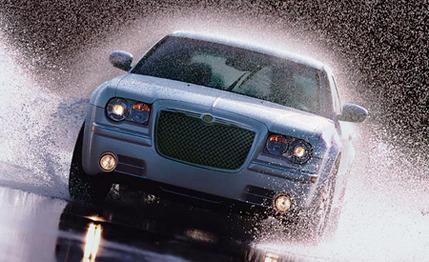 Short Take Road Test
Short Take Road Test

As a new-car publication, our aim is typically to be the first people in the newest cars, but this is a case of the opposite. The Chrysler 300 has been on the market since 2004 and has not radically changed since then. With its replacement just around the corner, we went in search of a last opportunity to get into the hard-charging, broad-shouldered sedan and lined up a test of the all-wheel-drive version of the Hemi-powered 300C.
All Wheels Driven, All Conditions Mastered
Although the 300’s rear-wheel-drive architecture never feels overpowered—even when the 425-hp, 6.1-liter SRT8 V-8 is wedged up front—the all-wheel-drive version with the 360-hp, 5.7-liter eight achieves a nearly perfect match of platform and power. With all four wheels driven, it feels as sturdy as Jefferson’s Monticello. Not even the most foolhardy moves can disturb the chassis. Full throttle and full lock from a dead stop? You’ll be changing direction very quickly, but you won’t be out of control—it makes entering traffic simple. Even on loose or slippery surfaces, the car is eminently controlled. Previous experiences with the car through a Michigan winter also found no surface the all-wheel-drive 300 didn’t positively dominate—this on the stock all-season tires. With a good set of winter tires, it might be able to climb Everest.
It’s a speedy snow plow, too. Updates have 20 more ponies at the Hemi party than when the car was introduced, bringing the total to the aforementioned 360. Torque drops an invisible single lb-ft to 389. With the benefit of all-wheel-drive traction, this 300C barrels to 60 mph in 5.3 seconds, dead on with the best figure we ever recorded for the previous, less-powerful rear-driver and a thrilling number for a plus-size executive sedan. The 5.7-liter still sounds great, too.
While they were reprogramming the Hemi, engineers swapped in a new all-wheel-drive system that completely decouples the front axle when the extra traction isn’t needed, thus reducing fuel consumption in dry, stable conditions. We observed an average of 18 mpg over more than 700 miles of testing, better than we ever recorded with a rear-drive 300C and 2 mpg better than the EPA city rating. On the highway, the EPA says the 300C AWD will see 23 mpg.
Ridin’ High, Not So Fly
Our biggest complaint about the supremely stable 300C is its stance. The all-wheel-drive version sits a bit higher than the rear-driver, and it looks a little truckish at the loftier elevation. Even with the 18-inch wheels fitted to our tester, the rolling stock can’t fill the fenders. Sadly, no larger hoops are offered. We also suspect the tottering height is at least partly responsible for the AWD car’s lackluster skidpad performance, where we clocked 0.80 g. It’s inhibited by stability control that can’t be fully defeated.
There is also wiggle room on the ride front. The all-wheel-drive car makes no changes to the 300’s suspension, aside from that little loft skyward, meaning the ride remains a masterful blend of comfort and composure. But it’s a blend that could afford the sort of degradation that comes from larger wheels. While we’re engineering our fantasy 300C, we’d tuck better binders behind our new wheels, too, as the car’s 190-foot stopping distance from 70 mph places it just to the wrong side of middle-of-the-road.
Aging Well
This final encounter proved once again what a capable platform the 300’s is. Hyundai’s Genesis sedan has been stealing the budget-luxury limelight lately—and granted, its interior makes the Chrysler’s look positively childish. But at $40,800 to start, the 300C AWD is still an impressive hulk of car for the money. For $2190, the Luxury Group II adds a jumble of odds and ends, the most important of which are better speakers and heated rear seats. Nine hundred bucks is a steal for the touchscreen entertainment/nav system with iPod control. Add a sunroof, an engine-block heater, and adaptive cruise control—which we recommend only if you hate yourself—and the sticker for our tester ends up at a true-luxury $45,475. We’ll take this opportunity to point out that a similarly equipped Dodge Charger AWD V-8 is about seven grand less.
We expect the 2011 300 will receive more of a face lift than a thorough reengineering, which we find somewhat disappointing, especially considering how much of its structure is drawn from the now-two-generations-past Mercedes-Benz E-class. In spite of this, though, the 300 remains a comfortable and competent car. We look forward to seeing what Chrysler can do with the next round.